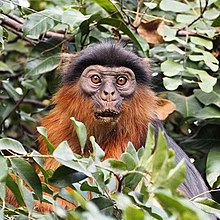|
Temminck's red colobus
Temminck's red colobus (Piliocolobus badius temminckii) is a type of red colobus monkey from the Gambia, Casamance, Guinea-Bissau and northwestern Guinea. It has historically been regarded as a subspecies of the western red colobus (Piliocolobus badius),[1] and the Integrated Taxonomic Information System and Mammal Diversity Database both maintain this classification,[3][4] but many less recent taxonomies classify it as a separate species (Piliocolobus temminckii).[5][6]  Temminck's red colobus generally lives in dry deciduous and gallery forests. In Senegal it also lives in savannah.[5] No other red colobus lives in savannah.[5] The use of savannah and open areas may be a recent adaptation to deforestation, since researchers in the 1970s always found Temminck's red colobus in tall, dense forest.[5] Temminck's red colobus living in savannahs often associate with green monkeys, and sometimes also associate with patas monkeys and bushbucks for defense against predators.[5][7] Temminck's red colobus differs from the Western red colobus in that the Western red colobus lives in rainforest rather than dry forest and savannah, which may explain differences in behavior.[6] The majority of its diet consists of fruit and leaves. Seeds, flowers, buds, bark and nuts account for most of the rest of the diet.[7] Temminck's red colobus is listed as endangered on the IUCN Red List of Threatened Species.[2] Primary threats include deforestation and hunting.[7] References
|
||||||||||||||||||||||||||||||||||||||||||||


